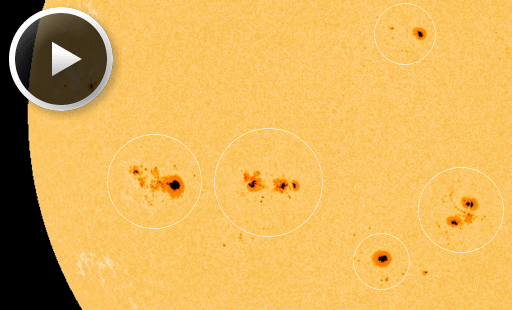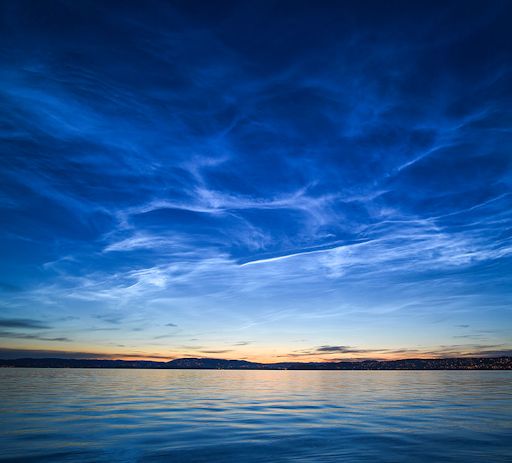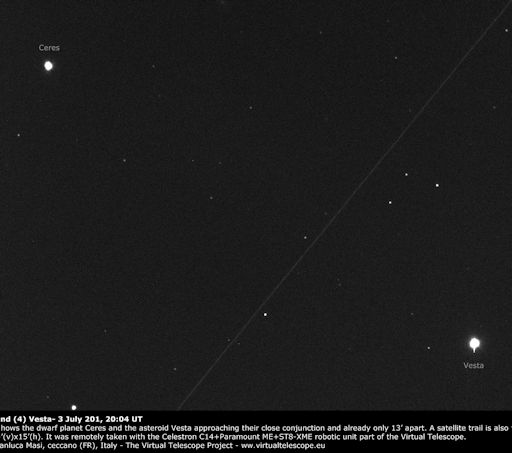Listen to radar echoes from satellites and meteors, live on listener-supported Space Weather Radio. | | |
MOSTLY QUIET WITH A CHANCE OF FLARES: Solar activity is low. However, there are five sunspots facing Earth that pose a threat for geoeffective flares: AR2104, AR2106, AR2107, AR2108, AR2109. NOAA forecasters estimate a 60% chance that one of those active regions will produce an M-flare during the 4th of July weekend. Solar flare alerts: text, voice
VERY SPOTTED SUN: Analysts have declared Solar Cycle 24 a "Mini Max" because the ongoing peak in solar activity is so much less intense than other solar cycles of the Space Age. However, today's sunspot count is anything but mini. NASA's Solar Dynamics Observatory captured this picture of multiple large sunspot groups sprawled across the face of the sun on July 5th:

Circled are the sunspot groups which pose a threat for geoeffective eruptions. Each one has a 'beta-gamma' magnetic field harboring energy for M-class solar flares. So far, the fireworks have been confined to Earth, but this could change before the weekend is over. Readers with solar telescopes are encouraged to monitor developments.Solar flare alerts: text, voice
Realtime Space Weather Photo Gallery
NOCTILUCENT OUTBURST: Sky watchers in Europe are reporting an outburst of bright noctilucent clouds (NLCs). The display began at sunset on July 3rd, filling northern horizons with electric-blue ripples, swirls, and tendrils of light. Morten Ross sends this picture from Sandbukta, Norway:

"An incredibly bright and widespread display - from northern horizon to zenith!" says Ross. "This is only the third night of July and its already much better than last year." Similar reports have come from France, Germany, Poland, the Netherlands, Scotland, Ireland, England, Estonia and Belgium.
Although most of the reports so far have come from Europe, the nights ahead could bring NLCs to North America as well. Monitor the realtime gallery for updates:
Realtime NLC Photo Gallery
NLCs are Earth's highest clouds. Seeded by "meteor smoke," they form at the edge of space 83 km above Earth's surface. When sunlight hits the tiny ice crystals that make up these clouds, they glow electric blue.
NLCs appear during summer because that is when water molecules are wafted up from the lower atmosphere to mix with the meteor smoke. That is also, ironically, when the upper atmosphere is coldest, allowing the ice crystals of NLCs to form.
The natural habitat of noctilucent clouds is the Arctic Circle. In recent years, however, they have spread to lower latitudes with sightings as far south as Utah and Colorado. This will likely happen in 2014 as well. Observing tips: Look west 30 to 60 minutes after sunset when the Sun has dipped 6o to 16o below the horizon. If you see luminous blue-white tendrils spreading across the sky, you may have spotted a noctilucent cloud.
MONSTER ASTEROIDS CONVERGE: The two most massive objects in the asteroid belt, dwarf planet Ceres and minor planet Vesta, are converging for a close encounter in the night sky on July 4th and 5th. Last night in Italy, Gianluca Masi used a remotely operated telescope to photograph the monster asteroids only 13 arcminutes apart--less than half the width of a full Moon. The line splitting the two is a terrestrial satellite:

At closest approach on July 5th, the two asteroids will be only 10 arcminutes apart in the constellation Virgo. They are too dim to see with the unaided eye, but easy targets for binoculars and small telescopes. Observing tips are available from Sky and Telescope.
Got clouds? You can watch the close encounter online. Choose between Gianluca Masi's Virtual Telescope Project (which begins July 5th at 4:00 p.m. EDT) or Slooh's webcast (July 3rd at 8 p.m. Eastern Daylight Time).
Quite near the two asteroids on the sky, though utterly invisible, is NASA's Dawn spacecraft. Dawn recently finished visiting Vesta and is now en route to Ceres. The ion-propelled spacecraft will enter orbit around Ceres next March. Cameras on Dawn will resolve the pinprick of light you see this weekend into a full-fledged world of unknown wonders. Stay tuned for that!
Realtime Comet Photo Gallery
Realtime Aurora Photo Gallery
Every night, a network of NASA all-sky cameras scans the skies above the United States for meteoritic fireballs. Automated software maintained by NASA's Meteoroid Environment Office calculates their orbits, velocity, penetration depth in Earth's atmosphere and many other characteristics. Daily results are presented here on Spaceweather.com.
On Jul. 5, 2014, the network reported 9 fireballs.
( 9 sporadics)

In this diagram of the inner solar system, all of the fireball orbits intersect at a single point--Earth. The orbits are color-coded by velocity, from slow (red) to fast (blue). [Larger image] [movies]
Potentially Hazardous Asteroids (
PHAs) are space rocks larger than approximately 100m that can come closer to Earth than 0.05 AU. None of the known PHAs is on a collision course with our planet, although astronomers are finding
new ones all the time.
On July 5, 2014 there were 1487 potentially hazardous asteroids.
Notes: LD means "Lunar Distance." 1 LD = 384,401 km, the distance between Earth and the Moon. 1 LD also equals 0.00256 AU. MAG is the visual magnitude of the asteroid on the date of closest approach. | | The official U.S. government space weather bureau |
| | The first place to look for information about sundogs, pillars, rainbows and related phenomena. |
| | Researchers call it a "Hubble for the sun." SDO is the most advanced solar observatory ever. |
| | 3D views of the sun from NASA's Solar and Terrestrial Relations Observatory |
| | Realtime and archival images of the Sun from SOHO. |
| | from the NOAA Space Environment Center |
| | the underlying science of space weather |

